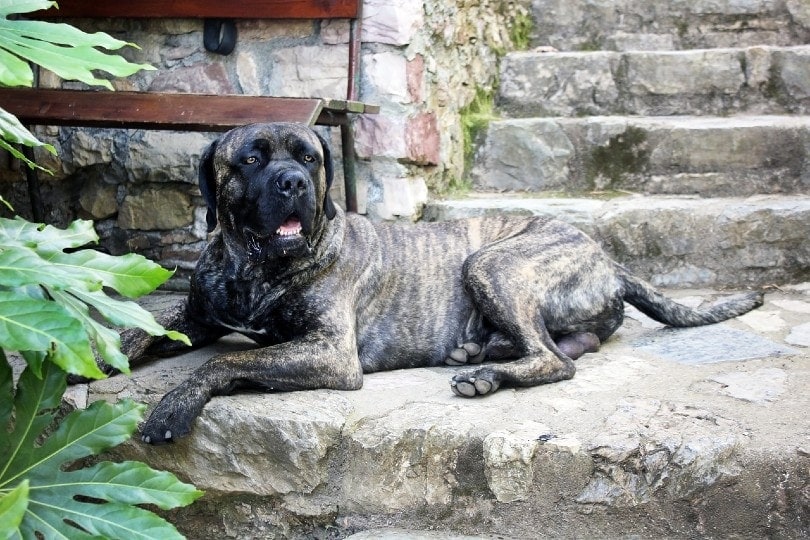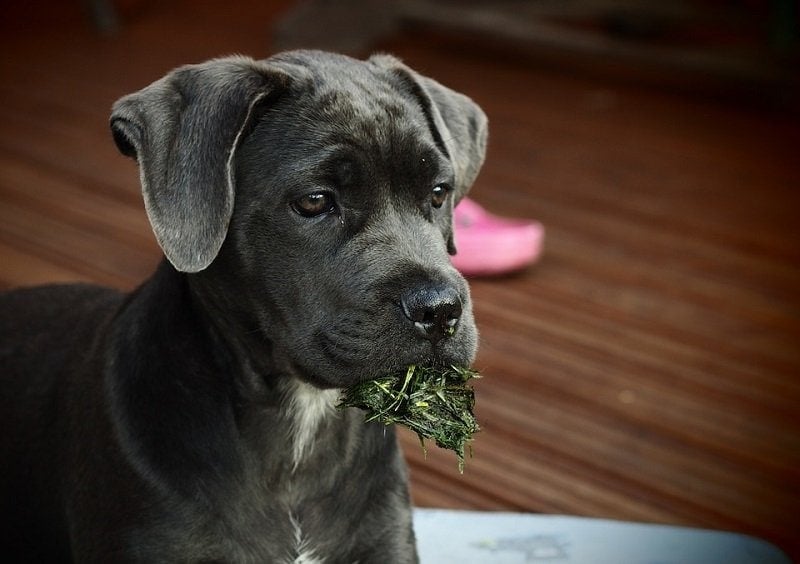What Were Cane Corsos Bred For? Breed History Explained
By Kit Copson
Updated on

The majestic Cane Corso is quite a sight to behold. These intelligent, dignified, no-nonsense giants turn heads and inspire awe in dog lovers everywhere they go. They’re fiercely protective of their humans and love to be kept busy, two traits retained from the breed’s days as working dogs—Cane Corsos were bred as battle dogs by the Romans, and later as game hunters and guard dogs.
 Cane Corso: Description
Cane Corso: Description
Before we get into the Cane Corso’s origins and history, we’ll first talk about how to identify a Cane Corso as they do share a lot of physical similarities with other mastiff breeds, especially the Neapolitan Mastiff to whom this breed is related.
The Cane Corso is a very large dog, with males sometimes reaching 27 inches (70 cm) tall. They are muscular, big-boned, and heavy, weighing between 90 and 110 pounds (40 and 50 kg). Their double coats are short, soft, and shiny and come in a range of colors including black, fawn, gray, red, and brindle.
Some Cane Corsos have white markings on their upper and/or lower chest, though the size of these markings varies greatly with some being barely noticeable and some appearing like a bib. Facially, Cane Corsos have a rather intimidating look with their massive heads, box-shaped muzzles, and serious-looking eyes. This doesn’t mean that Cane Corsos are mean, though—if socialized appropriately, they can be really friendly, loving dogs.
Naturally, Cane Corsos have soft, floppy ears though you’ll sometimes see them with shorter, pointier ears. This is because, controversially, some people have their Cane Corso’s ears cropped for cosmetic reasons. Sadly, some still choose to dock their tails, too.

Cane Corso: Origins and History – Pre A.D. 476 to Today
The Cane Corso breed has its origins in Ancient Italy. They descended from Roman war dogs who are believed to have descended from Molossians—an Ancient Greek dog breed. These dogs were first brought to Rome during the Macedonian wars, and the breeding of them resulted in the Cane Corso and the Neapolitan.
Cane Corsos were bred and used by the Romans for a time as battle dogs prior to A.D. 476. Viewed as bold, fearless, and indestructible, they usually had containers of flaming oil attached to their backs and were sent to wreak havoc across enemy lines.
Post A.D. 476: The Fall of the Roman Empire
When Rome fell in A.D. 476, these hard grafters were put to use in other ways. Having learned sheer discipline and hard work from their days as warrior dogs, Cane Corsos flourished in their new roles, which were largely guarding people and property and hunting wild boar and other animals. Some people acquired them for farm work to do tasks like pulling carts and sniffing out pests.
Cane Corsos came to be valued as multipurpose dogs that could do pretty much anything you trained them to do. They did their work seriously and diligently and took great pride in pleasing and protecting their owners. These characteristics have not been lost to the sands of time.

Disappearance and Revival: The 19th and 20th Centuries
Cane Corsos began to disappear in the 19th and 20th centuries and at one point, there were barely any Cane Corsos remaining. Some believed it to be the consequence of industrial changes, with machines doing the farm jobs that animals used to do.
Luckily, a traveling salesman and Cane Corso breed revivalist called Vito Indiveri spotted some dogs on a farm in the 1970s, recognizing them as Cane Corsos. Indiveri was one of a few Italians working to revive the breed, with the first Cane Corso club being formed in the 1980s. These efforts culminated in the breed avoiding extinction.
Cane Corsos in America
A Neapolitan Mastiff enthusiast called Michael Sottile contributed to the first Cane Corsos being imported into the U.S. in 1988, inspired by a dog-related chat with a farmer. The breed grew in popularity in the States over the next decades, with canine lovers quickly falling for these stunningly handsome, clever, and devoted dogs. People were also pleasantly surprised by how affectionate the seemingly imposing Cane Corso proved to be when socialized properly.

Cane Corsos Today: What Are Cane Corsos Like as Family Dogs?
The Cane Corso can be a great companion and family dog if socialized well by sensible dog parents with solid leadership skills. By nature and as a result of their hunting and working background, these dogs have big personalities and view themselves as leaders—if paired with a human that’s easily pushed around, the Cane Corso will completely run the show.
Because of these traits, a Cane Corso needs a dog parent who is confident, firm, consistent, and who stands for absolutely zero nonsense. This does not mean being aggressive or physical with your dog—it means showing your Cane Corso lovingly and calmly yet firmly who is in charge. It means being consistent and not letting your Cane Corso dominate you or your household.
For this reason, the Cane Corso isn’t recommended for first-time dog parents who don’t know the ropes when it comes to training. Cane Corsos need to be trained and socialized as early as possible to ensure they don’t become unmanageable. Though Cane Corsos are not usually a danger to the public, an untrained or badly treated one has the potential to be, just like any other dog breed.
A well-socialized Cane Corso is a real joy—a loving, loyal, and faithful family dog. A dignified dog with an innate suspicion of strangers, Cane Corsos will usually be indifferent to new people, though not aggressive. They need a lot of mental and physical stimulation due to their high intelligence and exercise needs.
To sum up, parenting a Cane Corso can be very rewarding if you can bring experience, good leadership skills, and a whole lot of time and effort to the table. These dogs live for around 9–12 years on average.
See Also:
- How Many Puppies Do Cane Corsos Have? 5 Determining Factors
- Were Cane Corsos Really Roman War Dogs? Origins & Facts
 Final Thoughts
Final Thoughts
We have to admit, we’re kind of in awe after learning about the noble Cane Corso. This is an ancient breed that has endured centuries of hard graft, has barked in the face of danger, and has returned from the very brink of extinction. On top of that, the breed has never lost its sense of honor and loyalty. In short, the Cane Corso commands nothing but the utmost respect!
Related Reads:
Featured Image Credit: akiragiulia, Pixabay
 Cane Corso: Description
Cane Corso: Description Final Thoughts
Final Thoughts








